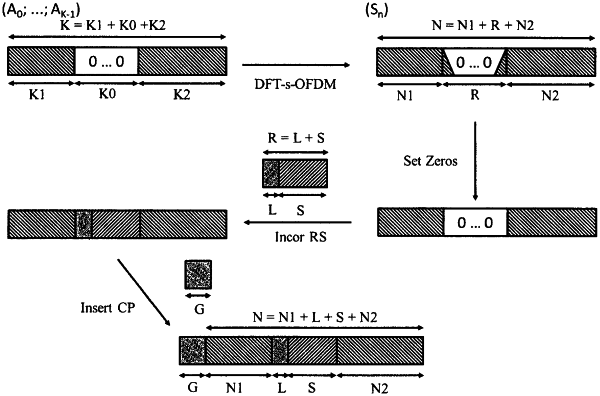| CPC H04L 27/2636 (2013.01) [H04J 13/0062 (2013.01); H04L 27/2607 (2013.01); H04L 27/2613 (2013.01)] | 18 Claims |

|
1. A method for transmitting at least a group of Kd data samples in a radio signal to be transmitted over a communication system, said radio signal being intended to be emitted by an emitter comprising at least one transmission module configured for transmitting on at least a number of K different sub-carriers, K and Kd being strictly positive integers, Kd being strictly smaller than K, said radio signal being provided by:
determining a first position J1 and a second position J2 in a block of K samples (A0; . . . ; AK−1), such that the block of K samples comprises:
Kd data samples to be transmitted;
and K0 consecutive samples (AJ1; . . . ; AJ2);
with J2−J1+1=K0 and Kd+K0=K;
applying a DFT-spread-OFDM-type scheme to the block of K samples A=(A0; . . . ; AK−1), and obtaining an output signal representing a symbol comprising N complex samples Sn in the radio signal, with n=0 to N−1;
determining, in the output signal, a first position T1 and a second position T2 based on J1, J2, K and N such that:
T2−T1=R, with R being a strictly positive integer;
setting, in the output signal, the values of the R complex samples (ST1; . . . ; ST2) between the first position T1 and the second position T2 to zero to obtain an updated output signal;
the method being characterized by:
inserting, between the first position T1 and the second position T2 of the updated output signal, S reference samples, S being a strictly positive integer and R=S+L, with L being a positive or null integer, to obtain a subsequent signal representing a hybrid symbol comprising:
for each of n=[0; T1−1]∪[T2+1; N−1], a complex sample Sn in the radio signal, the complex samples forming a data section of the hybrid symbol;
for each of n=[T1+L; T2], a reference sample RSn in the radio signal, the reference samples forming a reference section of the hybrid symbol;
appending, to the hybrid symbol, G samples forming a cyclic prefix of at least part of the hybrid symbol to obtain a signal representing the hybrid symbol appended with the cyclic prefix; in view of transmitting the radio signal corresponding to the signal representing the hybrid symbol appended with the cyclic prefix.
|